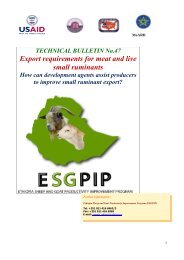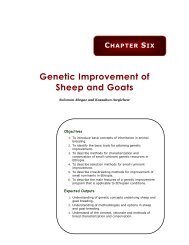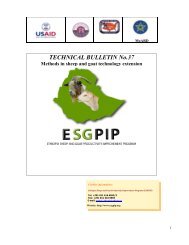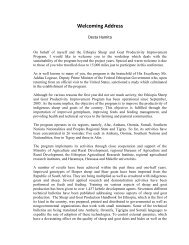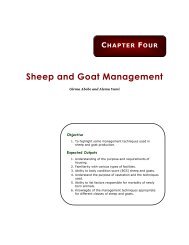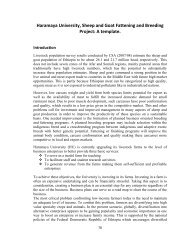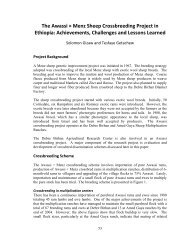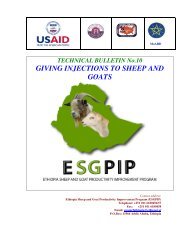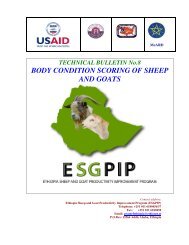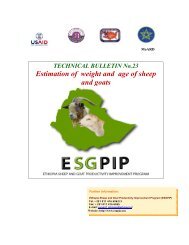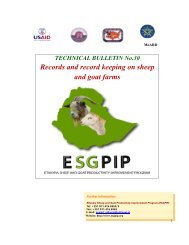TECHNICAL BULLETIN No.3 - esgpip
TECHNICAL BULLETIN No.3 - esgpip
TECHNICAL BULLETIN No.3 - esgpip
You also want an ePaper? Increase the reach of your titles
YUMPU automatically turns print PDFs into web optimized ePapers that Google loves.
MoARD<strong>TECHNICAL</strong> <strong>BULLETIN</strong> <strong>No.3</strong>CONTROL OF INTERNAL PARASITES INSHEEP AND GOATSContact address:Ethiopia Sheep and Goat Productivity Improvement Program (ESGPIP)Telephone: +251 011 6180456/57Fax: +251 011 6180458Email: pvamrfethiopia@ethionet.etP.O.Box: 15566 Addis Ababa, Ethiopia
TABLE OF CONTENTSFOREWORD ......................................................................................................................................iTABLE OF CONTENTS ..............................................................................................................ii1. Introduction....................................................................................................................................12. Signs of internal parasites in live animals..............................................................................13. Signs of worm infection in dead or slaughtered animals.................................................34. Types of internal parasites and their control ........................................................................34.1 Liver fluke..........................................................................................................................34.2 Gastrointestinal worms and lung worms.........................................................................54.3 Recommended time of anthelmintic treatment for small ruminants ....................64.4 Use of anthelmintics..............................................................................................................75. Principal anthelmintics ...............................................................................................................7ii
CONTROL OF INTERNAL PARASITES IN SHEEP AND GOATSBy: Sileshi Zewdie and Desalegn Lidetu Edited by: L. Dawson, R.C. Merkel and Alemu Yami1. IntroductionInternal parasites are worms. Worms are small creatures that are found inside animals.Sometimes they can be seen with the naked eye, but they are not easily seen in manycases. Unless you specifically look for worms in an animal that dies or which isslaughtered, you may not see worms. Helminthiasis results in the following economiclosses:Obvious losses: death, wasting, condemnation of human foodHidden losses: reduced live weight gain, poor food conversion, reduced lactation,poor fleece etc. The aggregate hidden losses are probably more serious thanobvious losses, but are often not noticed because:Such losses are widespread;The process is not easily observable and chronic;Most losses occur in young, growing animals and in those under physiologicalstress, when poor condition is regarded as normalControl costs: drugs, labor, fences, inefficient use of land etc.In Ethiopia, 5-7 million sheep and goats die each year due to diseases including helminthinfections. More significant, however, are losses resulting from inferior weight gains,condemnation of organs and carcasses and lower milk yields. The overall economic lossto the Ethiopian meat industry due to parasitic diseases is estimated at US$ 400 millionannually.2. Signs of internal parasites in live animalsSome animals are more badly affected by worms than others, while some animals neverdevelop a bad worm infection.How will you know if an animal is suffering from worms? There are a number of signsthat may indicate that an animal has worm infection. However, the signs will not tell youthat the problem is definitely caused by worms, but should make you suspicious. Here aresome of the signs.Bottle jawYou may notice that a sheep or a goat has a bottle jaw. This is a soft, coldswelling under the chin of the animal. It may be seen with a serious worminfection.Brisket edema- swelling between the front leg and belly.Pale mucous membrane (anemia)Some animals may be very pale when you look at the inside of the eyelid.This may be seen because of bad worm infection.Shabby wool or hair (poor condition)1
Animals may have poor hair or shabby wool during the dry season. You maynotice at first that sheep or goats are emaciated. You should feel the animalsover their lower backs.DiarrheaIt may be difficult to see that a sheep with a fat tail has diarrhea unless youlook carefully under the tail.Diarrhea can be caused by round worms, coccidian or liver flukes. It may alsohave other causes. Sometimes toxic plants or an inappropriate diet may causediarrhea.Weakness, depression and lying down abnormally.Stop eating or eating less than normal.Ewes or does may not have enough milk for their lambs or kids. The young maydie of starvation.Pass tapeworm segments in their feces.Loss of condition and rough haircoat(http://attra.ncat.org/attrapub/parasitesheep.html)Figure 1. Signs of parasitismBottle Jaw2
grass until it dries well and use it to make hay to feed the animals during the dry period.Pastures that remain wet for long periods are ideal environments for the survival ofinternal parasite larvae. Drainage fields reduce the larvae’s chances of survival andextend grazing periods. It is also important that animal watering areas be situated in welldrained places.The farmers/pastoralists using the same pasture should undertake control measurestogether and all sheep and goats that are grazing together should be treated at the sametime. Deworm all newly introduced sheep and goats and keep them separate from theflock for three daysIn the highlands where liver fluke is a problem: Deworm all sheep and goats in lateNovember or early December. Few liver fluke cysts can survive this long into the dryseason and few will be picked up until the end of the next rainy season. The seconddeworming can be at the end of April or beginning of May. In some areas where theproblem is severe, it may be necessary to treat all animals at the end of January orbeginning of February.In lowland areas where liver fluke is a problem: Deworm all sheep and goats in themiddle of the dry season (December), at the start of the short rainy season (March) and atthe start of the long rainy season (May).In mid-altitude areas where there is one long rainy season giving long crop growingperiods and where liver fluke is a problem: Deworm all young animals (below oneyear) every three months during the rainy season. Deworm all sheep and goats after therainy season (November). Deworm all sheep and goats before the beginning of the rains(May).Use narrow spectrum anthelmintics (Flukicide) against liver flukes. Most broad spectrumanthelmintics (against most nematodes and cestodes) have little or no effect on liverflukes.A= MiracidiaeB= SporocystC= RediaD= CercariaeE= Metacercariae ongrassF= Small intestineG= LiverFigure 3. Life Cycle of Fasciola hepatica4
4.2 Gastrointestinal worms and lung wormsSince the susceptibility of animals varies with age, it is important, especially in the rainyseason, to graze young stock in advance of older stock. Using cut and carry feedingsystems can significantly limit worm infestation. Overpopulation increases theconcentration of parasites and also forces animals to graze closer to the ground, and mayresult in consumption of a higher number of infective larvae.All farmers/pastoralists using the same pasture have to take control measures at the sametime. Deworm all newly introduced animals and keep them separate for three daysbefore allowing them to mix with the rest of the flock. Keep barns clean and dry.In highland areas, with short rains followed by long rains:Deworm all sheep and goats at the end of the rainy season when the pasturebecomes dry: December.Deworm all sheep and goats at the end of the dry season before the rain starts:AprilIn lowland areas where there are two distinct rainy seasons.Deworm all sheep and goats at the end of the dry season (February) before therains start.Deworm all sheep and goats at the end of each of the rainy seasons:September and April.In mid-altitude areas where there is one long rainy season giving long cropgrowing periods:Deworm all sheep and goats after the rainy season: NovemberDeworm all sheep and goats before the beginning of the rains: MayAlways consider the possibility of acute parasitic gastroenteritis at any timefrom the start of the rains until shortly afterwards.Figure 3. The life cycle of a typical gastrointestinal parasite worm:5
Strategic deworming using a FAMACHA© card can be established in intensive farms inthe Rift Valley where haemonchus is prevalent. FAMACHA© is a technique developedin South Africa that is used to identify anemic animals on a 1 to 5 scale. The system isbased on examination of the lower eyelid of sheep and goats and comparison with theFAMACHA© color chart depicting varying degrees of anemia. This test is used todetermine the need for anthelmintic treatment. Administration of treatment should followonly if anemia (a sign of parasitism) is present. The FAMACHA© card can be orderedthrough animal health input suppliers and training on how to use it can be obtained fromveterinary professionals.Figure 4. use of the FAMACHA chart (http://www.scsrpc.org)4.3 Recommended time of anthelmintic treatment for small ruminantsTable 1: Schedule for treatment of small ruminants in different ecological zonesMonthJanuaryFebruaryMarchAprilBroad-spectrum AnthelminticsMid altitude(Woinadega)Highlands(Dega)Lowlands(Kola)Highlands(Dega)FlukicideMid altitude(Woinadega)Lowlands(Kola)MayJuneJulyAugustSeptemberOctoberNovemberDecember6
4.4 Use of anthelminticsStrategic deworming of animals with approved drugs is an important strategy incontrolling internal parasites.Annual rotations of anthelmintic drugs are not recommended anymore as this canincrease rate of resistance to all drugs. Using one class of a broad spectrum drug until it isno longer effective and then switching to another class of a broad spectrum drug isconsidered a better strategy. The new strategy is thus recommended for use. Moreover, itis necessary to consider the following points seriously:Use a full dose of anthelmintic whenever treatment is done. This is recommendedto help prevent the development of resistance.Treat all newly introduced animals before allowing them to mix with theremaining flock.There are different formulae and presentations of anthelmintic drugs. The following aresome examples:Boluses/pills or tablets - these are easy and practical for useLiquid preparations/drenches - these are ready to use preparations, availablelocallyPastes - easy to give if you have a dispenser. Not commonly available locallyMedicated blocks - difficult to control the amount of drugs absorbed. Notavailable locally.Slow-release formulations - drug is placed in the rumen and released slowly on acontinuous basis. Not available locally.5. Principal anthelminticsBenzimidazoleAlbendazole - trade name Valbazen. It is active against nematodes such asHaemonchus, and other trichostrongyles (round worms), to some extent liverflukes (Fasciola hepatica), tapeworms (Moniezia, Taenia saginata), etc. Dosage is5 mg/kg for round worms and 10 mg/kg for flat worms (trematodes).Thiabendazole - trade name TBZ, Thibenzole. Active against gastrointestinalround worms. Recommended dose between 75 mg/kg and 120 mg/kg (usually 80mg/kg).Triclabendazole - trade name Fasinex. Active against liver flukes. Recommendeddose, 10-12 mg/kg.Imidazothiazole derivativesTetramisole hydrochloride - trade name is Nilverm. Active against gastrointestinaland lungworm. Recommended dose, 15 mg/kg.Levamisole hydrochloride - trade name is Ripercol. Active against gastrointestinaland lungworm. Recommended dose, 7.5 mg/kg7
SalicylanidesOxyclozanide - trade names, Diplin, Zanil. Active against adult liver flukes.Recommended dose, 15 mg/kg.Rafoxanide - trade name Ranide, Flukanide. Active against immature and adultliver flukes and also against abomasal and intestinal roundworms. Recommendeddose against immature and adult liver flukes is 7.5-10 mg/kg. Only 5 mg/kgagainst adult Fasciola.MiscellaneousIvermectin is active against gastrointestinal and lung worms. Recommended dose,200 mcg / kg.Combinations of anthelminticsSeveral anthelmintics can be combined to increase the spectrum of activity of the drugs.Such combined drugs are available in the market. Some examples are:Nilzan: oxyclozanide + tetramisoleRanizole: rafoxanide + thiabendazoleTable 4. Anthelmintics for sheep and goatsGeneric name Common commercialnamesDosage(mg/kg)Spectrum of activityGI L T FBENZIMIDAZOLEAlbendazole Valbazen 5-10 + + + +Thiabendazole Thibenzole 80 + + - -Triclabendazole Fasinex 10-12 + - - +IMIDAZOTHIAZOLESLevamisole hydrochloride Ripercol 7.5 + + - -Tetramisole hydrochloride Nilverm 15 + + - -SALICYLANIDESRafoxanide Ranide 7.5 + - - +Oxyclozanide Zanil - - + +MISCELLANEOUSIvermectin Ivermectin 0.2 + + -GI = Gastrointestinal nematodes, T = Tapeworms, L = Lungworms, F = Liverfluke+ = Effective, - = Ineffective8



